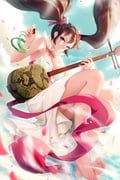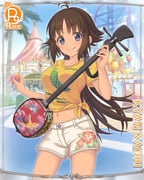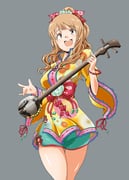sanshin
The sanshin (三線, literally "three strings") is an Okinawan musical instrument and precursor of the Japanese shamisen. Often likened to a banjo, it consists of a snakeskin-covered body, neck and three strings.
Its close resemblance in both appearance and name to the Chinese sanxian suggests its Chinese origins, the old Ryūkyū Kingdom (pre-Japanese Okinawa) having very close ties with China. In the 16th century, the sanshin reached the Japanese trading port at Sakai in Osaka, Japan. In mainland Japan, it evolved into the larger shamisen.
In mainland Japan, many people refer to the sanshin as jabisen (蛇皮線, literally "snake-skin strings") or jamisen (蛇三線, "snake three strings") because the body of the instrument has a snakeskin covering. Traditionally, it was covered with the skin of the Burmese python, but today, due to CITES regulations, the skin of the python reticulatus is also used, as well as cloth. A bamboo bridge raises the strings off the skin.
The Sanshin is played either with the traditional plectrum, made of horn and worn on the finger, the nail of the index finger, or, more recently, a guitar pick.
Directly after WW2, with a scarcity of materials, Sanshin were made with flat tin cans and scrap wood, called Kankara Sanshin (かんから 三線). These are still produced today, either as inexpensive instruments or, more often, souvenirs.








